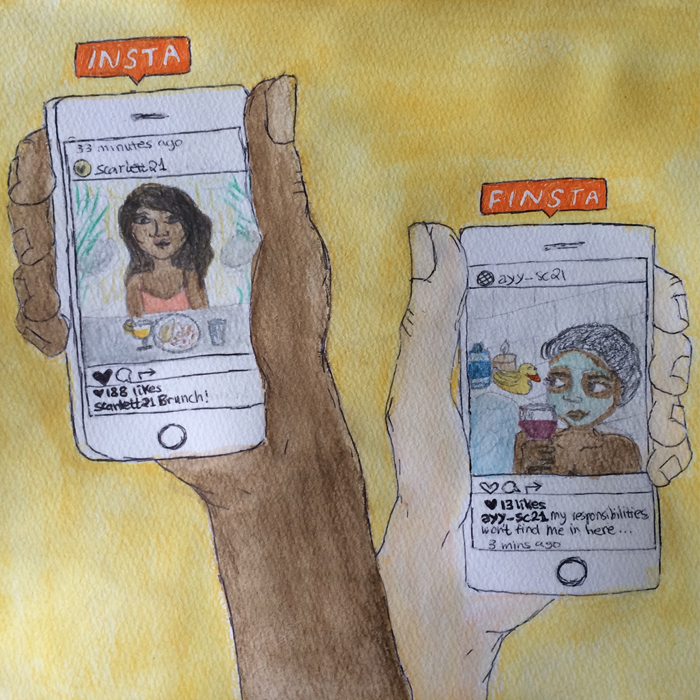Commonly referred to as ‘finstagram,’ or ‘finsta,’ the ‘Fake Instagram’ phenomenon is on the rise. A rather curious oxymoron, the trend is taking over the popular and ever-evolving Instagram app.
Over the past decade, the world has witnessed a digital boom, revolutionizing how—and what—people share. Within seconds, social media users can broadcast their new job promotion or upcoming travel plans to hundreds of followers and ‘friends.’ Social media has given individuals control over how others perceive their lives.
Users tend to post about their high moments and none of their lows, effusing an image of perfection. This tendency to share only the happiest moments of one’s life manifests itself more so on Instagram—currently the top photo-sharing application—than on other platforms, such as Facebook or Twitter. Of the millions of user accounts, most contain photos of friends, family, smiling people, and happy memories—a testament to the constant projection of perfection.
According to Urban Dictionary, finstagram stands for “a mixture of fake & Instagram.” In practice, the way some McGill students use their extra—and extra-goofy—accounts conveys a sense of realness and humanness that their official profiles do not.
Hana Geadah, U1 Arts & Science, is among the many students who have a finstagram—except unlike most others, she has two. Her “mainstream” finsta, as she calls it, is the classic personal account filled with photos she deems to be as too intimate or too ugly for her official Instagram page. But her second account takes an altered, offbeat approach—it is dedicated to her hookups.
Geadah made her hookup finsta in May 2016, inspired by a friend of a friend. Only close friends who she approves can follow this private account. She has her own protocol for posting on this account, too. A photo and short bio accompany every hookup, briefly describing the individual and the encounter. And if she happens to come into contact with that person again, Geadah turns to Instagram’s story feature to keep her followers informed with a photo of the person, as well as a status-update.
“I like it because I can just be really sassy about the people who I hook up with,” Geadah said, with a laugh. “And, it’s also good because basically my best friends who follow the account can just see, and if they want to talk to me about it they can.”
On a platform as vast and revealing as Instagram, the posting of one’s private life seems counter-intuitive. But through her second finsta, Geadah is breaking many stigmas surrounding sex, being a woman, and being queer.
“I feel like there’s a stigma or a shame about ‘look at all these people I hookup with,’ [more so] as a girl, especially as a queer girl,” Geadah said. “I remember when I had a girlfriend, I felt super self-conscious about posting on my real Instagram, pictures with her.”
Geadah’s use of her finsta as a platform of real and unrestrained expression defies the ways in which individuals control their image on social media. The finstagram trend isn’t restricted to the typical self-management of one’s account; the possibilities for creativity and expression are endless.
Jamie Woods* and Emma Buscher*, both U1 Arts, also employ this creative use of finstagram. Best friends and avid finsta users, their take on the trend is unique: They run each other’s accounts. Woods created Buscher’s account originally as a birthday joke, but it’s still active months later. For the pair, running each other’s finstas means letting go of the constant need to micro-manage one’s image. It’s also a telling sign of trust in one another.
“I really like finstas because I feel there’s just this kind of togetherness and community about the way we run them,” Buscher said. “[…] Even though it’s run by someone else, you can trust them, and I think that’s really important.”
The two friends often post embarrassing selfies of each other, and fun selfie submissions from their followers. They also strive to promote self-care amid academic stress. Woods and Buscher know each others’ midterm and exam schedules, and aim to post kind words for each other to see.
“Every single time one or the other [have] a test coming up, [we] always post an encouraging post, like, ‘Look at them go,’” Buscher said.
Having control of each other’s finsta accounts is an essential counter to the social pressure to have everything seem perfect on their official Instagram accounts.
“It’s definitely a paradox,” Woods said. “[…] Your finsta is supposed to be your fake-self, but it’s really your actual self versus the rinsta, which is more how you want people to perceive you on a social level [….] We derive so much of our self-worth in how people perceive us on social media.”
The rise of finstas is a large collective statement on social media; it is a rebuke of the constant management of image, a challenged to the need to portray perfection. Rarely will one find posts about a failed exam or a panic attack, but these accounts are moving in the direction of normalizing the imperfections that everyone has, but rarely shows.
*Names have been changed at the request of the source.









It’s been a long time I actually pulled out a piece of paper to take notes on a blog post. Thanks for this. You’ve earned yourself a new reader!